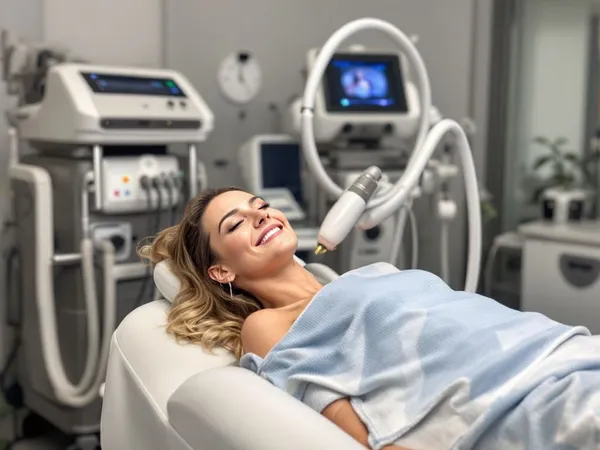Cavitation Treatment: Revolutionizing Non-Invasive Fat Reduction
Cavitation treatment is transforming the way we approach fat reduction, offering a safer, non-invasive option for achieving a contoured body effortlessly.
Cavitation treatment is at the forefront of non-invasive fat reduction techniques, offering a remarkable alternative to traditional methods such as liposuction. This innovative technology uses ultrasonic waves to break down fat cells, leading to a more sculpted and toned body. One of its major selling points is that it doesn’t require surgery, thus reducing recovery time and risks associated with invasive procedures. As more individuals seek effective and convenient ways to lose fat, cavitation is becoming increasingly popular for its efficacy and safety. In this blog, we will delve into how cavitation works for weight loss, explore the best machines for home use, consider the side effects and risks, and compare it with other methods like CoolSculpting.
Understanding How Cavitation Works for Weight Loss
Cavitation technology is a revolutionary approach in the realm of non-invasive weight loss treatments, primarily utilizing ultrasonic waves to target and dismantle localized fat cells. This process, known as ultrasonic cavitation, involves the emission of low-frequency sound waves that penetrate the skin and create microscopic bubbles in the fat tissue. These bubbles expand and contract rapidly, causing the fat cells to break apart and transform into free fatty acids and glycerol. The body then naturally processes these substances through the lymphatic system and liver, ultimately excreting them as waste. This method is particularly effective for targeting stubborn fat deposits that are resistant to diet and exercise, making it an attractive option for those seeking to refine their body shape without the need for surgical intervention.
One of the key benefits of cavitation treatment is its ability to reduce body circumference and improve skin texture without the downtime associated with surgical procedures. Unlike liposuction, which requires anesthesia and recovery time, cavitation is a painless procedure that can be performed in a clinic or even at home with the best cavitation machine for home use. This convenience, coupled with the non-invasive nature of the treatment, has contributed to its growing popularity among individuals seeking effective weight loss solutions. Furthermore, studies have shown that cavitation can lead to significant reductions in body measurements, particularly in areas such as the abdomen, thighs, and arms, where fat tends to accumulate.
Despite its many advantages, it is important to be aware of the potential cavitation side effects and risks. While generally considered safe, some individuals may experience temporary redness, swelling, or bruising in the treated areas. Additionally, those with certain medical conditions, such as liver disease or pacemakers, should consult with a healthcare professional before undergoing cavitation treatment. Understanding how cavitation works and its potential outcomes can help individuals make informed decisions about incorporating this technology into their weight loss regimen. By doing so, they can achieve their desired results while minimizing any potential risks associated with the procedure.

Exploring the Best Cavitation Machines for Home Use
As the popularity of non-invasive weight loss treatments continues to rise, many individuals are turning to home-use cavitation machines as a convenient alternative to clinical procedures. These devices allow users to perform ultrasonic cavitation treatments in the comfort of their own homes, making it easier to integrate into daily routines. When exploring the best cavitation machines for home use, it's essential to consider several factors to ensure you achieve optimal results. Firstly, the effectiveness of a cavitation machine largely depends on its ability to emit low-frequency ultrasonic waves that can penetrate the skin and target fat cells effectively. High-quality machines often combine ultrasonic cavitation with additional technologies such as radiofrequency and infrared light, which can enhance fat reduction and promote skin tightening.
Another critical aspect to consider is the ease of use and safety features of the cavitation machine. The best cavitation machines for home use are designed with user-friendly interfaces and come with clear instructions to ensure safe operation. Many devices also include adjustable settings, allowing users to customize their treatment according to their specific needs and comfort levels. Additionally, safety certifications and positive user reviews can provide further assurance of a machine's reliability and effectiveness. It's also beneficial to look for machines that offer multiple treatment modes, as this versatility can address various areas of the body, such as the abdomen, thighs, and arms, where stubborn fat tends to accumulate.
When selecting a cavitation machine for home use, it's important to consider the potential cavitation side effects and risks. While generally safe, some users may experience mild side effects such as redness or swelling, which typically subside quickly. To minimize these risks, it's advisable to follow the manufacturer's guidelines and consult with a healthcare professional if you have any pre-existing medical conditions. By carefully evaluating these factors and choosing a reputable device, individuals can enjoy the benefits of ultrasonic cavitation at home, achieving significant improvements in body contour and skin texture without the need for invasive procedures. This approach not only offers convenience but also empowers users to take control of their weight loss journey with confidence.

Cavitation Side Effects and Risks: What You Need to Know
While cavitation is widely regarded as a safe and effective method for non-invasive fat reduction, it is essential to be aware of the potential side effects and risks associated with the treatment. Understanding these aspects can help individuals make informed decisions and take necessary precautions to ensure a safe and successful experience. One of the most common cavitation side effects is temporary redness or mild bruising in the treated areas. This occurs due to the ultrasonic waves' impact on the skin and underlying tissues, which can cause minor irritation. However, these effects are typically short-lived and subside within a few hours to a few days post-treatment.
Another potential risk of cavitation treatment is swelling, which may occur as the body responds to the breakdown of fat cells. This swelling is usually mild and temporary, but it can be uncomfortable for some individuals. To minimize this risk, it is crucial to follow the manufacturer's guidelines and any advice provided by a healthcare professional. Staying well-hydrated before and after the treatment can also help reduce swelling and enhance the body's ability to process and eliminate the broken-down fat cells. Additionally, maintaining a healthy lifestyle, including a balanced diet and regular exercise, can further support the body's natural detoxification processes and improve cavitation for weight loss results.
It is important to note that certain individuals may be at a higher risk of experiencing adverse effects from cavitation. Those with pre-existing medical conditions, such as liver disease, kidney problems, or pacemakers, should consult with a healthcare professional before undergoing ultrasonic cavitation. This is because the treatment may exacerbate certain conditions or interfere with medical devices. Furthermore, pregnant or breastfeeding women are generally advised to avoid cavitation treatments due to the lack of research on its safety in these populations. By understanding the potential cavitation side effects and risks, individuals can take proactive steps to ensure a safe and effective treatment experience, ultimately achieving their desired body contouring goals with confidence.
Comparing Cavitation and CoolSculpting: Which is Better?
When it comes to non-invasive fat reduction treatments, both cavitation and CoolSculpting have gained significant popularity due to their effectiveness and minimal downtime. However, understanding the differences between these two methods is crucial for individuals looking to choose the best option for their weight loss goals. Cavitation, also known as ultrasonic cavitation, utilizes low-frequency sound waves to create microscopic bubbles in the fat tissue. These bubbles cause the fat cells to break apart, transforming them into free fatty acids and glycerol, which the body naturally processes and eliminates. This method is particularly effective for targeting stubborn fat deposits that are resistant to diet and exercise, offering a more immediate benefit in terms of skin tightening and body contouring.
On the other hand, CoolSculpting, or cryolipolysis, operates on a different principle. It involves the application of controlled cooling to freeze and destroy fat cells in targeted areas. The frozen fat cells undergo apoptosis, a natural cell death process, and are gradually eliminated by the body's lymphatic system over a period of weeks to months. One of the key advantages of CoolSculpting is its ability to precisely target specific fat pockets, making it ideal for individuals looking to address localized areas such as the abdomen, flanks, or thighs. However, unlike cavitation, CoolSculpting does not provide immediate skin-tightening effects, and results may take longer to become visible.
Choosing between cavitation and CoolSculpting ultimately depends on individual goals, preferences, and the specific areas being targeted. For those seeking a quick reduction in body circumference and improved skin texture, cavitation may be the preferred option. It is also more accessible for home use, with the availability of the best cavitation machines for home use. Conversely, individuals looking for precise fat reduction in specific areas may benefit more from CoolSculpting, despite the longer wait for results. It is important to consult with a healthcare professional to assess personal health conditions and determine the most suitable treatment. By understanding how cavitation works compared to CoolSculpting, individuals can make informed decisions and achieve their desired cavitation for weight loss results while minimizing potential cavitation side effects and risks.
Ultrasonic Cavitation: Revolutionizing Non-Invasive Fat Reduction
Ensuring Safety and Efficacy in Cavitation Treatments
Frequently Asked Questions
What is cavitation treatment?
How does cavitation work for weight loss?
What are the best cavitation machines for home use?
What are the potential side effects and risks of cavitation?
How does cavitation compare to CoolSculpting?
Is cavitation treatment safe for everyone?
How often should I use a cavitation machine at home?
What results can I expect from cavitation for weight loss?
Discover the path to your healthiest and most beautiful self with estethica's award-winning services. Call now for a free consultation and experience the highest standards of care and innovation.
📞 Call Now